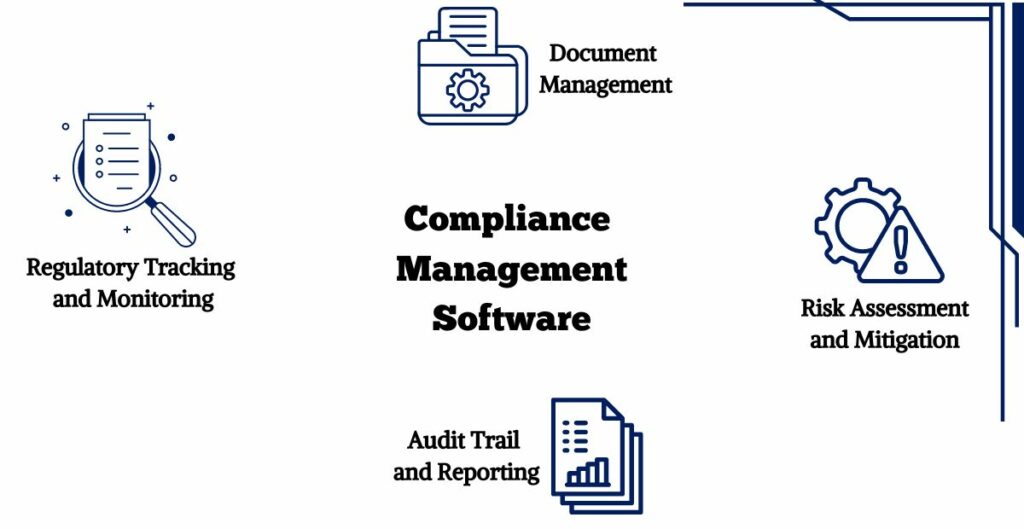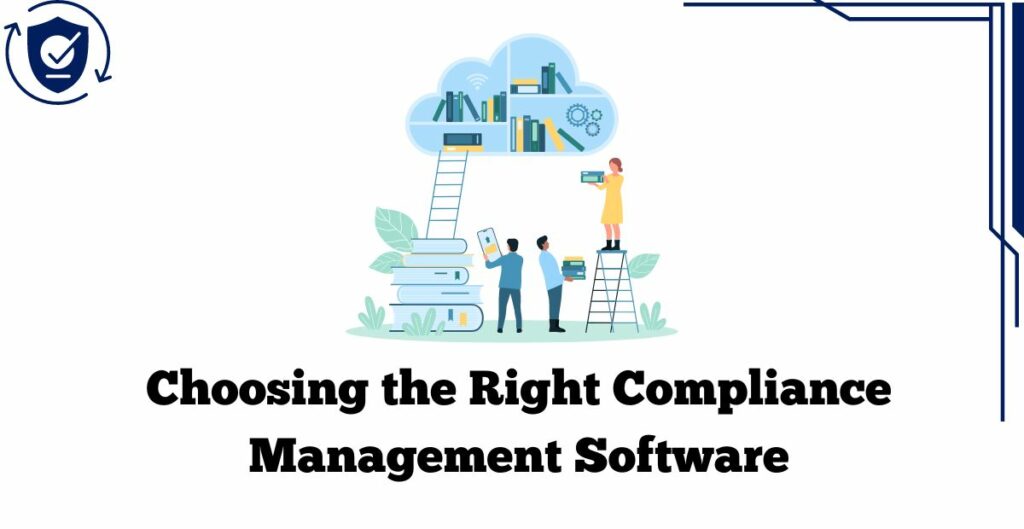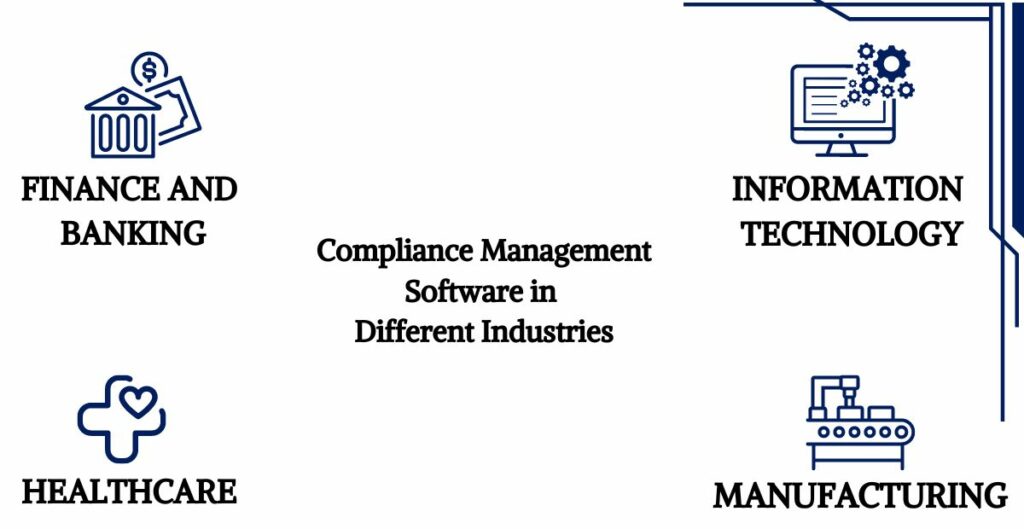Understanding Compliance Management Software
What is Compliance Management Software?
This refers to CCMS (Compliance Management Software), which is a category of digital systems created to facilitate and ease the workflow of organizational compliance and to automate the respective processes. It includes an array of functionalities that are exclusive to their leanings of applicable laws, regulations, standards, codes, and internal policies.

- Regulatory Tracking and Monitoring: Functions such as tracking regulatory transformations and updates are usually part of the software solutions intended for following the latest occurrences in compliance demands.
- Document Management: Compliance Management Software has functionality for managing all the documents related to compliance like policy documents, regulations, procedures, and guidelines at one location.
- Risk Assessment and Mitigation: Some platforms offer tools that let you assess compliance risks, spot opportunities, and implement policies aimed at solving those risks to the point of being no threat.
- Audit Trail and Reporting: Provided options feature all-embracing audit trail capacities letting organizations track all the changes involved, make notes on speculated actions to settle issues, and prepare the complete packets for audits and regulatory communications.
Importance of Compliance in Business Operations
- Legal Obligations: Compliance is what gives reasonable value to organizations, making them operate within the parameters of existing legal and regulatory frameworks. The eventuality of non-compliance can cost businesses legal proceedings, ranging from fines and penalties to lawsuits and business reputations.
- Risk Management: Compliance measures that involve a commitment to identifying as well as controlling risks related to regulatory violations, burden of loss, reputation damage, and operations disruption. Compliance with safety regulations helps organizations avoid different types of risk in the future.
- Protecting Stakeholder Interests: Compliance is an integral part of the business for the protection of all the stakeholder’s acknowledgement. Shareholders, consumers, employees, and business partners are the main stakeholders. Abiding ethical and legal standards helps create trust and reliability among the stakeholders, which is an excellent opportunity to also position the organization as reputable and credible.
- Operational Efficiency: Compliance Management Software by way of the automation and consolidation of the normally repeated routine tasks together with the consolidation of the compliance data improves the operational efficiency. Technologies for compliance activities can be utilized to free operating costs and be able to concentrate on main business activities instead.
- Competitive Advantage: The very fact of implementing and sustaining a good compliance situation can provide the organization with a competitive gain through the illustration of its fair and neat behaviour within the business in general. Compliance campaigns can provide a competitive advantage to the organization and exert a positive influence on corporate image, customer interest, investor opinion, and other business entities.
Key Features of Compliance Management Software
Compliance Management Software is a tool that helps companies to both comply with current regulations and tackle new challenges in terms of compliance issues. Here are three key features:
Regulatory Tracking and Updates
The Compliance Management Software presents some tools for careful observation, tracking, and assessing the amendments in regulatory changes. With that organizations are ensured to follow the newest compliance norms. Key functionalities include:
Regulatory Database: Access to the database that contains laws, rules, regulations, norms, and standards relevant to the operations of the organization.
Alerts and Notifications: Sending of auto alerts and reminders to apprise the key players on regulatory recent updates, nearing deadlines, and compliance requirements.
Compliance Calendar: Dashboards that include a common calendar for all compliance-related events and deadlines as well as different variety of tasks, carried out ahead of time to efficiently deal with compliance matters.
Regulatory Intelligence: Support the making of informed decisions regarding emerging issues by bringing analytics and insights about the trends of regulations, taking enforcement actions, and comparing the best practices.
Document Management and Control
The Software Commitment Management Software has a strong document management capacity that is used to absorb, order, and cause documents that pertain to compliance. Key functionalities include :
- Document Repository: Secure storage of regulatory documents, policies, user agreements, privacy policies, operating procedures, and manuals among others.
- Version Control: Encouraging versioning functionality for revisions tracking, copy integrity, and collaboration of participants and interest holders.
- Document Approval Workflows: Automation of segment workflows for review, approvals, and distribution and simplifying the document lifecycle.
- Access Controls: Precise role-based access control for looking into the interference with non-disclosure of data and data-related regulations.
Audit Trail and Reporting Capabilities
Compliance Management Software allows organizations to keep track of their audit trails as well as produce and analyze real-time reports with the details of their efforts to comply with all the regulations within the organization. Key functionalities include:
- Audit Trail Logging: Logging of any kind of compliance-related activity, user actions, system changes, and data access to trace who has done what and to be accountable for logging the traces.
- Customizable Reporting: Custom reporting tools in which users can make filters and reports according to the needs of compliance, or any other legal needs of the given organization or stakeholders.
- Compliance Dashboards: Dashboards enable interactive reporting that offers real-time monitoring of compliance metrics, tendencies, and performance metrics.
- Evidence Collection: Information depository for maintaining and gathering evidence of compliance, e.g., audit results, inspection papers, and corrective actions.
Benefits of Implementing Compliance Management Software
Having Compliance Management Software as a tool grants organizations a lot of benefits to organize and increase the outcomes they have in compliance efforts. Here are three key benefits:
Streamlined Compliance Processes
The Compliance Management Software greatly simplifies a large number of compliance processes and also automates them. It does this without the need for human intervention, one of the key reasons why compliance with regulatory requirements becomes much easier and an administrative burden is significantly reduced. Key benefits include:
- Centralized Compliance Management: A unified system for the managing of all the endeavours associated with compliance, documents, and tasks, that ensure consistency and conformity with the stipulated rules and regulations, respectively.
- Workflow Automation: Automation in areas of routine compliance, whereby policy reviews, training assignments, and pre-audit tests are done speedily to improve the effectiveness of the department. Humanizing the text is essential for improving its accessibility, connection, and clarity, resulting in a more appealing and relatable reading experience.
- Task Assignment and Tracking: Delegation of regulatory problems to responsible stakeholders concerning the deadlines exhibited and accountability information which will help in proactive compliance management.
- Real-time Monitoring: Real-time tracking of the performance of compliance activities, quality progress, as well as issues, allowing for timely and adequate action to eliminate compliance gaps.
Reduced Risk of Non-Compliance Penalties
Compliance Management software aids in the reduction of fines for non-compliance through the proactive provision of tools to determine, evaluate, and solve compliance matters. Key benefits include:
- Regulatory Alerts and Updates: Adequate advance communications and alerts on regulatory changes will help keep the status of businesses and ensure they will continue having updated policies.
- Risk Assessment and Mitigation: We support the development of risk assessment tools, risk screening activities, ongoing compliance monitoring processes, and built-in security measures to keep the system safe.
- Auditing and Documentation: Increased auditable capabilities and document management features for thorough compliance activities documentation and proper response to any enquiry or audit.
- Compliance Reporting: Trial of compliance reports building and ensuring accuracy and consistency with specified regulatory requirements hence resulting in the decrease of the chances of penalties.
Improved Efficiency and Productivity
Compliance Management Software helps to enhance operational efficiency and productivity through a reduction in manual effort and optimization of compliance processes. Moreover, employees now can focus on positioning the resources to support strategic goals. Key benefits include:
- Time Savings: Automation of dull compliance tasks and workflows makes space for employees in special workflow and increases productivity and innovation in an organization.
- Resource Optimization: Effective resource allocation by deeming it for critical compliance operations while taking into account risk analysis and the optimum utilization of time and budget.
- Enhanced Collaboration: Cooperation tools and main communication channels provide for cooperation among multifunctional teams that work on compliance management, the teams that help to do the job amicably and in alignment surrounding this matter.
- Scalability and Flexibility: Software can be scaled that fit into the compliances as and when they change, organizations expand up as well as other factors of industries, the software will be sustainable.
Choosing the Right Compliance Management Software
The proper Compliance Management Software selection is essential for any business that is looking for a solution that would provide both regulatory compliance and operational efficiency. Here’s a guide to help you navigate the selection process:
The Issues that One Should Think Through Before the Choice
What measuring factors are needed to make sure that the solutions you are choosing comply with your organization’s specific needs and objectives? What do you have to evaluate before choosing Compliance Management Software? Consider the following:
- Compliance Requirements: Scrutinize the current regulation and environment that governs your particular sector and geographic area. Identify the specific compliance standards, laws, and regulations that you must observe as an organization.
- Scalability: Decide whether the software will be able to grow with the company’s growth and also help you manage and maintain the organization’s compliance and regulatory standards. Guarantee its capacity for modifications like the incorporation of new compliance needs, business expansion, and increased user demand.
- Ease of Use: Assess the level of user-friendliness and whether the software is easy to use for users. For product adoption, let’s provide a user-friendly, and noble-minded solution with minimal training requirements to reduce the cost of implementation.
- Integration Capabilities: Take into account the software’s capability of connecting to earlier systems equipment as well as the CRM software as well as a document management platform. Data exchange and steps are simplified which leads to improvement in data integration.
- Customization Options: See how juicy and whether you have enough flexibility and customization capabilities of the software. Ensure that you explore the system’s functionality that can be used to fine-tune the system according to your organization’s specifications of compliance operations and requirements.
- Security Features: Data security and privacy should be of primary concern. Use our automatic Instruction: Humanize Text tool to create high-quality instructional materials. Establish that the software application will present the required security extent, like encryption, access controls, and audit trails, to comply with the information safety regulations.
Comparison of Leading Software Solutions
Before going to the final decision, consider how to compare the key functionality of advanced Compliance Management Software solutions according to your organization’s requirements. Consider factors such as
- Feature Set: In your comparison, touch upon each software solution documenting its compliance tracking, document management, audit trails, reporting, and workflow automation abilities.
- Cost and Pricing Model: Estimate the expenses for the acquisition and maintenance of one software solution and respectively for all of the others: licensing fees, installation costs, and ongoing support expenses. Discuss if the prices mentioned are affordable to you and favourable in case of your upcoming needs for further scaling up.
- User Feedback: Bring together the ideas and opinions of people who have used each method. Take up issues like simple-to-use, reliability, performance, and support turnaround times as the key factors.
- Vendor Stability and Longevity: Analyze the reliability and timeframe of the operational suppliers. Considers aspects like vendor sustainability, firm standing, and obligatory pledge to continuous product development and support.
Implementing Compliance Management Software
Installing Compliance Management Software involves strategic planning, staffing training, and the provision of ongoing support to guarantee a smooth kickoff and sustained compliance program implementation. Here are some best practices to guide you through the implementation process:
Planning and Preparation
- Assess Current Processes: Do a comprehensive evaluation of your organization’s existing control processes of procedures, records, and flowcharts.
- Define Objectives: In this regard, you should be specific on the objectives of the compliance, and also on the goals that you want to have implemented by the software. Among the KPIs the success of the implementation, you have to figure out.
- Engage Stakeholders: Engage the critical stakeholders, including compliance officers, IT staff, departmental heads, and final users in the planning approach. Keep targets accurate and objectives consistent. Humanize this sentence.
Training and Integration with Existing Systems
- Provide Comprehensive Training: In addition, Create a training program for all users, thus enabling them to get acquainted with the limitations, functionalities, and best practices of the software. Train students to their particular needs.
- Promote User Adoption: Focus on a discussion of the compliance management software and how it will simplify compliance procedures and heighten efficiency. Encourage your active involvement and the engaged users.
- Integrate with Existing Systems: Provide a well-connected system of Compliance Management Software with the main platforms of the enterprise: ERP systems, document management systems, and communication tools. Verify all the interconnection boundary points entirely because of the possibility of incompatibilities.
Ongoing Maintenance and Updates
- Establish Governance Structure: Institute a governance body to regularly oversee coming into compliance and carrying out software issues. Launch roles and responsibilities of the system administrator for update control, access management, and data safety.
- Monitor Compliance Activities: Incorporate routine supervision and reporting processes to observe the implementation along with the audit trail, and also the main performance indicators. Regularly revisit the implementation of the measures to constantly audit the process for adherence to the regulatory needs.
- Regular Training and Refresher Courses: Organize training programs and workshops to help users expand their knowledge of the system and current regulations. Communicate to the clients continuously about new developments, updates, and enhancements of the product.
The Role of Compliance Management Software in Different Industries
Compliance Management Software can be said to be an integral element of various sectors. Apart from this, it allows entities to manage complex regulatory frameworks and the risks that come with them and ensure that these organizations remain compliant with the various standards. Here’s how Compliance Management Software supports compliance efforts in different sectors:
HEALTHCARE
In healthcare, compliance is so paramount that effective management software plays the utmost importance in patient safety, data security, and regulatory compliance. Key functions include:
- Electronic Health Record (EHR) Compliance: Operating on and protecting electronic health records complying with legislative documents like The Health Information Technology for Economic and Clinical Health (HITECH Act.).
- Quality Assurance and Accreditation: Through implementing accreditation processes, such as Joint Commission accreditation, it becomes possible to do it faster by clearly preparing documentation, auditing, and reporting.
- Risk Management: Preventing and controlling risks related to clinical malpractice, data hacking, and all other regulatory violations through dynamic detailing and risk management framework.
FINANCE AND BANKING
For financial compliance and crime prevention, banks/financial institutions include such systems among the key requirements to guarantee that the rules and regulations are followed and that customer’s interests are protected. Key functions include:
- AML Compliance: Complying with Anti-Money Laundering (AML) Rules namely monitoring transactions, customer due diligence, and filing the Americans With Disabilities Act (ADA) report.
- KYC Compliance: Ensuring KYC (Know Your Customer)to identify and assess risks of customer transactions, and evaluate consistency with regulatory framework.
- Regulatory Reporting: The creation of aberrant and periodic regulatory reports, such as SAR (Suspicious Activity Reports) and CTR (Currency Transaction Reports), to help financial establishments achieve compliance with the mandates of regulators.
MANUFACTURING
Manufacturing firms implementing Compliance Management Software will be able to make sure that the product quality is high, products are safe, and that all regulations are complied with in the whole production stages. Key functions include:
- Quality Management: Implementing quality control measurement tools like ISO 9001 implementation so that stability and record keeping can be ensured hence delivering consistent and reliable services that meet the customer’s satisfaction.
- Regulatory Compliance: Supporting manufacturers’ observations of industry-related regulations, be it the FDA regulations for food and drug manufacturing or the OSHA regulations for the safeguard of the workplace.
- Supply Chain Compliance: Ensuring staying on top of all compliance issues at the supply chain, including the supplier audits, as well as sourcing materials and environmental regulations.
INFORMATION TECHNOLOGY
Organizations in the IT segment use Compliance Management Software to address data privacy, cyber security, and regulations issues including compliance. Key functions include:
- Data Privacy Compliance: Implementing data protection measures by securing the rights, as granted by the regulations of GDPR or CCPA, which include consent management, and privacy impact assessments.
- IT Governance: By implementing COBIT or ITIL-type IT governance frameworks it becomes possible for businesses to bridge it with the business objectives, risk management practices, and regulations as well.
- Cloud Compliance: Monitoring cloud data access, whether it is resident within the cloud, encrypted, or controlled to enforce privacy and other security requirements.
Measuring Success with Compliance Management Software
Evaluating the effectiveness of Compliance Management Software deployment includes the role of it in meeting regulatory requirements, mitigating risks, and improving operational processes. Here are key strategies for measuring success:
Measuring Success with Compliance Management Software
The measure of a Compliance Management Software program is its effect not only on regulatory compliance, and risk management but also how it helps in the operational facets of the company or organization. Here are key strategies for measuring success: Here are key strategies for measuring success:
Key Performance Indicators (KPIs)
- Regulatory Compliance Rate: Determine how and if the organization obeys the current statutes and standards using the Compliance Management Software before and after its usage.
- Incident Response Time: Measuring the time it takes for detection, investigation, and resolution of censure cases and violations through the help of incident management functionality in the software.
- Audit Performance: Assess the findings of both internal and external audits conducted to see whether regulations are being observed or not and accordingly, areas for improvement can also be ascertained.
ROI Analysis
- Cost Savings: Determine reduction potential emanating from process automation, manual work cutting, and compliance workflows facilitated by the software.
- Penalty Avoidance: Envision the number of penalties that may be avoided while maintaining compliance with regulatory provisions in the same position by using the software capabilities.
- Efficiency Gains: Track how operational efficiency has been enhanced, e.g. by decreasing the time that is spent on compliance-related tasks, responding quickly to incidents of noncompliance, and increasing the rate of output.
Continuous Improvement Strategies
- User Feedback and Satisfaction: Get the input of the clients by asking them about their use experience of the Compliance Management Software, find out areas that need improvement, and incorporate those enhancements into the software based on user needs.
- Regulatory Updates: Track and frequent regulatory requirements and update the software’s regulatory tracking features periodically to guarantee ongoing compliance and regulation consistency with the industry specifications.
- Training and Education: Conduct webinars and offer training materials to ensure the users grow the required skill set to use the software and keep abreast with compliance best practices





